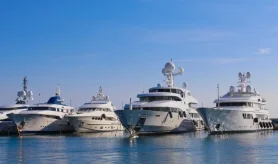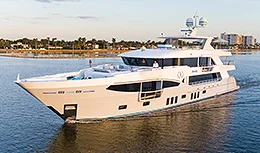- Alaskan Yachts
- Azimut Yachts
- Back Cove Yachts
- Beneteau Yachts
- Benetti Superyachts
- Bertram Yachts
- Boston Whaler
- Broward Yachts
- Buddy Davis Sportfish
- Burger Yachts
- Cabo Yachts
- Catamarans
- Carver Motoryachts
- Center Console
- Chris-Craft Yachts
- Cruisers Yachts
- DeFever Trawlers
- Dufour Sailboats
- Fairline Yachts
- Feadship Yachts
- Ferretti Yachts
- Filippetti Yachts
- Formula Yachts
- Fountaine Pajot Cats
- Grady-White
- Grand Banks Trawlers
- Hargrave Yachts
- Hatteras Yachts
- Hinckley Picnic Boats
- Horizon Yachts
- Hydra-Sports
- Intrepid Boats
- Jarrett Bay Sportfish
- Jeanneau Yachts
- Kadey-Krogen Trawlers
- Lazzara Yachts
- Lekker Boats
- Luhrs Sportfish
- Marlow Yachts
- Maritimo Yachts
- Marquis Yachts
- Mazu Yachts
- McKinna Motoryachts
- Meridian Yachts
- Midnight Express
- MJM Yachts
- Mochi Craft
- Neptunus Motoryachts
- Nordhavn Trawlers
- Nordic Tugs
- Numarine Yachts
- Ocean Alexander Yachts
- Ocean King
- Offshore Yachts
- Outer Reef
- Oyster Sailing Yachts
- Pacific Mariner Yachts
- Palmer Johnson Yachts

Sailboat Racing's Foiling Revolution: Life on the Edge
The last decade has seen high-performance sailboat racing transformed almost beyond recognition by a global technology and design revolution.
This article was written by Justin Chisholm. Photography courtesy of Kevin Rio, Studio Borlenghi, and Loris Von Siebenthal.
The advent of new high-tech materials and fresh thinking about the fundamentals of how racing sailboats of all sizes are designed and built has morphed the sailing into a brand-new fast and furious, high-adrenaline, high stakes, and highly professional sport.
The boats in this brave new world still harness only the power of the wind, but now instead of riding over the waves, they fly above the water at previously inconceivable speeds delicately balanced on finely tuned hydrofoil wings.
This foiling revolution, as it is known, has been made possible by the advent of new, high-tech, super-light, and ultra-strong materials, along with huge advances in yacht design software and marine construction techniques.
The impact has been felt across the sailing world and spawned a new generation of foiling sailors with the innate skill and technique required to get the best out of boats that fly rather than sail.
From tiny featherlight dinghies to midrange one design monohull sports boats and catamarans and on to gigantic oceangoing craft capable of circumnavigating the planet, no area of high-performance sailboat racing has been left untouched.

The America’s Cup
Through the 140+ year history of sailing’s oldest and most prestigious international spectacle, the America’s Cup has always been a design-led competition that encompassed the very latest leading-edge technology, design, and construction techniques.
The tried and trusted adage “the fastest boat always wins the America’s Cup” is yet to be disproved, and so it was inevitable that foiling would at some point play a part.
America’s Cup boats first took to the air during the 34th edition of the event staged in San Francisco in 2013. Truth be told, the 72-foot (21.95-meter) AC72 catamarans were not supposed to be able to foil.
But when the wily New Zealand syndicate cunningly devised a way to get its boat up on foils, the other three teams were left scrambling to catch up. The America’s Cup was now officially part of the foiling revolution—and there would be no going back.
Fast forward to 2021 and the 36th America’s Cup in New Zealand, where an ultra-radical new 75-foot (22.86-meter) foiling monohull class—the AC75— was introduced.
Although in the buildup to the event there were plenty of spectacular high-speed wipeouts as the four international teams came to grips with this brand-new sailing concept, by the time racing began the crews could complete 20-minute races at speeds of up to 50 knots (57.54 miles per hour/92.6 kilometers per hour) without the hulls of their boats ever touching the water.

A lighter and more powerful version of the AC75 will be used to contest the 37th America’s Cup in Barcelona, Spain in the winter of 2024, when “cyclers,” using legs rather than arms, will generate the hydraulic power required to keep the boats in the air.
America’s Cup holders Emirates Team New Zealand have also introduced a smaller AC40 foiling monohull class for the preliminary events for the 2024 regatta. At just 40 feet, the new one design class is based on the team’s Cup-winning AC75 and will be sailed by a crew of four.
As well as being used by the AC teams for development and training purposes, the new AC40s will be used for the separate Youth and Women’s America’s Cup events, which will be held in parallel with the main event.
Hopes are also high that the AC40 could establish itself as a one design class in its own right away from the America’s Cup if the right caliber of private owners could be found.
SailGP
Created by Kiwi America’s Cup winner Russell Coutts and backed by American software billionaire Larry Ellison, SailGP is sailing’s first professional global racing circuit featuring 10 national teams.
The racing is in 50-foot (15.24-meter) ultra-high-performance foiling catamarans, which evolved from the AC50s used in the 35th and 36th America’s Cups.
Billed as the Formula 1 of sailing, SailGP is made up of professional teams representing Australia, Canada, Denmark, France, Great Britain, Japan, New Zealand, Spain, and Switzerland.
Each season the circuit visits eight major cities across Europe, the United States, Australia and New Zealand, and Bermuda.

The events feature six races over two days, and the combination of high-speed boats, super competitive teams, and a compact race area consistently makes for fast and furious action. While the races draw huge spectator fleets out on the water, many more people watch the action live online and on national TV.
Each SailGP season builds to a climax at the circuit’s grand finale event when the top teams battle it out for the SailGP championship title and a $1M cash prize.
The foiling revolution has inspired the world’s top designers to create a remarkable tranche of monohull and multihull foiling boats that are capable of crossing oceans and even racing nonstop around the world.
Ocean foiling is centered around two main classes of boat: the 60-foot monohull IMOCA 60 and the 105-foot (32-meter) Ultim multihull, both of which originate in France, the universally acknowledged spiritual home of offshore yacht racing.
IMOCA 60
Foiling offshore in big waves requires a different design approach to inshore events like the America’s Cup and SailGP.
Foiling IMOCA 60s do not rise completely out of the water. (A class-enforced design rule precludes the necessary t-foils on the rudders.) Nevertheless, the performance boost from using foils is significant. Top speeds are in the 30–35 knot range and an IMOCA 60 at full chat is a truly spectacular sight.
Foiling IMOCA 60s were introduced for the eighth edition of the Vendée Globe nonstop singlehanded around-the-world race, which took place over the winter of 2016–17.
The class has also been adopted for The Ocean Race, the high-profile, professional, fully crewed, multistage race around the world schedules to start from Alicante Spain, in January 2022.

ULTIM
Meanwhile, in the larger Ultim multihull class created in 2015, there are no limitations on how the crews achieve wide open water flight.
Ultim boats can be a maximum of 32 meters (105 feet) long and 23 meters (75.46 feet) wide. New boats cost around 10 million Euros (11.2 million US Dollars); a fleet of six boats backed by a set of major corporate sponsors is actively racing at events like the Route du Rhum and Transat Jacques Vabre.
A singlehanded around-the-world race for Ultim boats is scheduled to take place in 2023, when iconic skippers like Thomas Coville, Francois Gabart, Armel Le Cléac’h, Charles Caudrelier, Yves Le Belvec, and Yann Guichard will attempt to beat the Gabart’s remarkable 2017 record-setting circumnavigation of just 42 days, 16 hours, 40 minutes, and 35 seconds.
FLYING NIKKI
A brand-new 60-foot inshore/coastal foiler based on America’s Cup design concepts has been developed for a European private owner. Designed for the founder of the classic 151 Miglia-Trofeo Cetilar regatta in the Mediterranean, the spectacular Flying Nikka turned plenty of heads when it debuted at this year’s Maxi Yacht Rolex Cup in Porto Cervo, Italy.
One Design Inshore Foiling Classes
The foiling revolution has also sparked an explosion of smaller one design classes—both monohull and catamaran—that are providing exciting airborne racing for crews made up of professional and amateur sailors.
69F Class
The 69F is a new three-person high-performance foiling monohull class aimed at bringing foiling monohull racing to a mainstream audience. 2021 saw a fleet of 1-12 teams racing on the inaugural European circuit, and in 2022 the class expanded into the United States.
GC32 Class
The GC32 is a well-established high-performance foiling catamaran class. Measuring 12 meters (39.37 feet) by 10 meters (32.81 feet) and with a crew of five, GC32s are among the fastest boats in the world.
The European racing circuit—the GC32 Racing Tour—attracts a high-caliber fleet that combines some of the best amateur teams competing with professional crews from SailGP and the America’s Cup.
TF35 Class
Developed for the predominantly light wind racing conditions on the inland lakes of Switzerland and Italy, the TF35 catamaran is a newer, and arguably higher-performance, rival to the GC32.
Designed by some of the best-known names in foiling racing, the TF35 class was founded in 2020; the European circuit has attracted a fleet of seven top-flight teams.

Request A Copy
Special Thanks to Our Partners








